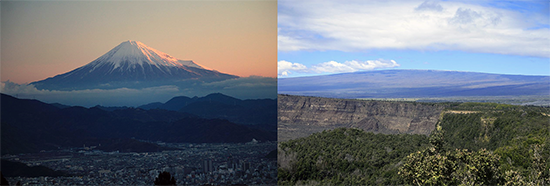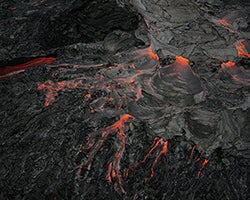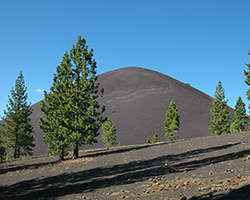
Alien Lava
 Imagine a tall mountain coughing up smoke and spewing red hot lava. Ash falls from the sky and hot lava pours across the barren land. If you had to guess, where do you think this might this be? Places like Hawai’i or Italy might come to mind. But what you might not realize is that volcanoes are everywhere, even on moons and other planets. Why are they everywhere? And what can they tell us?
Imagine a tall mountain coughing up smoke and spewing red hot lava. Ash falls from the sky and hot lava pours across the barren land. If you had to guess, where do you think this might this be? Places like Hawai’i or Italy might come to mind. But what you might not realize is that volcanoes are everywhere, even on moons and other planets. Why are they everywhere? And what can they tell us?
Volcanoes are how planets (and some moons) get rid of heat. When people get hot, we can sweat to cool off. Planets use volcanoes to cool themselves off and the lava can be thought of as “sweat”. Although different volcanoes cool off in much the same way, they sometimes “sweat” a little differently from one another. Volcanoes and lava features can look quite different depending on where you look. For example, compare the difference between Mt. Fuji and Hawai’i.
 So far, we know volcanoes are found on Mercury, Venus, Earth, the Moon, Mars, and Jupiter’s moon, Io. Right now, active volcanoes are only found on two of these bodies: Earth and Io. However, volcanoes could be erupting on Venus or Jupiter’s moon, Europa. We are unable to see if they are due to Venus’s thick atmosphere and Europa’s thick ice shell.
So far, we know volcanoes are found on Mercury, Venus, Earth, the Moon, Mars, and Jupiter’s moon, Io. Right now, active volcanoes are only found on two of these bodies: Earth and Io. However, volcanoes could be erupting on Venus or Jupiter’s moon, Europa. We are unable to see if they are due to Venus’s thick atmosphere and Europa’s thick ice shell.
If most of these planets and moons are no longer active, how do we know that volcanoes were on their surfaces? Because of the landforms they made. Landforms are geomorphic (shaped by land) features found on the surface of a planet. Hills, plains, valleys, and mountains are all landforms. The different landforms created by volcanoes can tell us why, when, and how the volcanoes erupted.
Channels: Reading the Land
You’re watering the plants in your front porch, and water starts flowing down your sloped driveway. As the water flows downhill, it flows on specific pathways. This creates little rivers – or channels – down your driveway. Sometimes lava flows in a similar way.
Lava channels are some of the most common lava flow landforms. The lava pours out of the volcano quickly and flows downhill. Like the water in the driveway, the lava will form channels as it flows downhill. Lava channels – like rivers – sometimes curve back-and-forth and create snake-like pathways. Lava channels usually form embankments that contain the flow, just like rivers. Once the lava stops flowing through the channel, the channel empties and cools. However, the channel and banks are left behind. We can see many lava channels on Venus, the Moon, and Mars, which tells us that hot lava once flowed across their surfaces.
Lava Flows & Flood Lavas
Perhaps the most common way lavas flow out of volcanoes are in large sheets. When you spill water on flat ground, the water spreads across the ground as a broad flow – or sheet flow – as it moves across the surface. Lava behaves in a similar way and lava flows sometimes appear as large sheets.
 If you spill a lot of water on the ground, it flows farther and sometimes makes a puddle. Something similar happens with lava. When lots of lava erupts and makes lots of lava flows, the lava flows grow longer and sometimes form a very large “puddle” of lava. The lava flows will also stack on top of each other like a stack of books. This is known as a flood lava. Flood lavas can take years or even centuries to form. The Colombia River Basalts in eastern Washington and Oregon are an example of this. Lava flows and flood lavas, similar to what we observe in places like Hawai’i and the Columbia River Basalts, are observed on Mercury, Venus, the Moon, Mars, and Io.
If you spill a lot of water on the ground, it flows farther and sometimes makes a puddle. Something similar happens with lava. When lots of lava erupts and makes lots of lava flows, the lava flows grow longer and sometimes form a very large “puddle” of lava. The lava flows will also stack on top of each other like a stack of books. This is known as a flood lava. Flood lavas can take years or even centuries to form. The Colombia River Basalts in eastern Washington and Oregon are an example of this. Lava flows and flood lavas, similar to what we observe in places like Hawai’i and the Columbia River Basalts, are observed on Mercury, Venus, the Moon, Mars, and Io.
Shields and Cones
When most of us think of volcanoes, we think of tall, conical mountains like Mount Fuji. But volcanoes can also resemble large, broad hills, like Mauna Loa, Hawai’i. These are called shield volcanoes because they look like upside down shields. Shield volcanoes are made of dozens, hundreds, or thousands of overlapping lava flows from repeated eruptions. We observe shield volcanoes on the Moon, Venus, and Mars (remember Olympus Mons!).
 Small cone-shaped volcanoes can be produced by a single eruption of lava that explodes a little at the surface. Sometimes this happens because the lava erupts so fast that it tears itself into tiny pieces called “cinder” or “spatter”. This cinder or spatter can build little mountains called cinder cones or spatter cones. Sometimes hot lava will interact with groundwater at the start of an eruption. This causes the water to vaporize, or turn into steam very quickly and explode. This process can produce sand-sized pieces of cooled lava called “tuff” and produce little tuff cones.
Small cone-shaped volcanoes can be produced by a single eruption of lava that explodes a little at the surface. Sometimes this happens because the lava erupts so fast that it tears itself into tiny pieces called “cinder” or “spatter”. This cinder or spatter can build little mountains called cinder cones or spatter cones. Sometimes hot lava will interact with groundwater at the start of an eruption. This causes the water to vaporize, or turn into steam very quickly and explode. This process can produce sand-sized pieces of cooled lava called “tuff” and produce little tuff cones.
We observe cones on the Moon and Mars. Those on the moon are thought to be cinder or spatter cones since there is no water near the surface. The cones on Mars are likely cinder, spatter, and tuff cones because of the presence of water-ice near the surface. Unlike other volcanoes, these cones are usually formed from one eruption and never erupt again.
Calderas
 The term caldera can mean somewhat different things on different planets. In general, though, these are large depressions – big holes in the ground – that tell us where magma (lava before it erupts) was stored. Magma is stored underground in magma chambers. When a volcano erupts, that magma leaves the chamber and erupts on the surface as lava. Once the magma chamber has been emptied, the land sinks downward. This produces a caldera.
The term caldera can mean somewhat different things on different planets. In general, though, these are large depressions – big holes in the ground – that tell us where magma (lava before it erupts) was stored. Magma is stored underground in magma chambers. When a volcano erupts, that magma leaves the chamber and erupts on the surface as lava. Once the magma chamber has been emptied, the land sinks downward. This produces a caldera.
Sometimes the eruptions responsible for draining the magma chamber and the resulting caldera occur many kilometers away from each other. Other times, lava lakes will form within the calderas. Calderas are found on Venus, Mars, and Io.
Additional images via Wikimedia Commons. Image of lava flows on Io by JPL's Voyager 1 spaceprobe.
Bibliographic Details
- Article: Alien Lava
- Author(s): Sean Peters
- Publisher: Arizona State University Learning Enterprise Ask An Earth & Space Scientist
- Site name: ASU - Ask An Earth And Space Scientist
- Date published:
- Date modified:
- Date accessed: December 18, 2025
- Link: https://askanearthspacescientist.asu.edu/explore/alien-lava
APA Style
Sean Peters. (). Alien Lava. Retrieved {{ nothing_3 }}, from {{ view_node }}
American Psychological Association, 6th ed., 2nd printing, 2009.
For more info, see the
APA citation guide.
Chicago Manual of Style
Sean Peters. "Alien Lava." ASU - Ask An Earth And Space Scientist. Published . Last modified . https://askanearthspacescientist.asu.edu/explore/alien-lava.
Chicago Manual of Style, 17th ed., 2017.
For more info, see the
Chicago Manual citation guide.
MLA Style
Sean Peters. Alien Lava. ASU - Ask An Earth And Space Scientist. , {{ view_node }}. Accessed 2025, Dec 18.
Modern Language Association, 8th ed., 2016.
For more info, see the
MLA citation guide.

Lava flows originating from a volcano on one of Jupiter's moons, Io.
Be Part of
Ask An Earth and
Space Scientist
By volunteering, or simply sending us feedback on the site. Scientists, teachers, writers, illustrators, and translators are all important to the program. If you are interested in helping with the website we have a volunteers page to get the process started.

